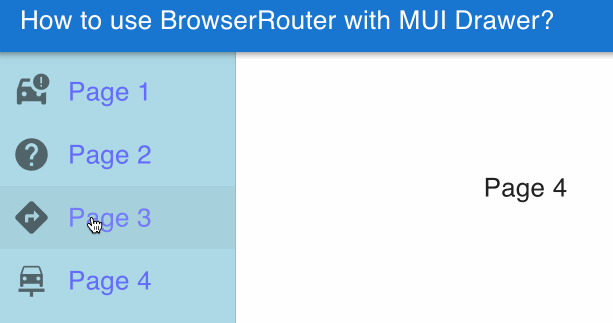I have prepared a simple test case at Github for my question:
In my App.jsx there is following code:
<NavDrawer />
<BrowserRouter>
<Routes>
<Route path="page1" element={<Page1 />} />
<Route path="page2" element={<Page2 />} />
<Route path="page3" element={<Page3 />} />
<Route path="*" element={<Page4 />} />
</Routes>
</BrowserRouter>
And in the NavDrawer.jsx I have the code:
const drawerLinks = [
{ text: "Page 1", path: "/page1", icon: <CarCrash /> },
{ text: "Page 2", path: "/page2", icon: <Help /> },
{ text: "Page 3", path: "/page3", icon: <Directions /> },
{ text: "Page 4", path: "/page4", icon: <CarRepair /> },
];
function MyListItem({ text, path, icon }) {
return (
<ListItem disablePadding>
<ListItemButton>
<ListItemIcon>{icon}</ListItemIcon>
<Link to={path}>
<ListItemText primary={text} />
</Link>
</ListItemButton>
</ListItem>
);
}
export default function NavDrawer() {
return (
<Drawer>
<BrowserRouter>
<nav>
<List>
{drawerLinks.map((item, index) => (
<MyListItem key={index} icon={item.icon} text={item.text} />
))}
</List>
</nav>
</BrowserRouter>
</Drawer>
);
}
Unfortunately, nothing happens when I click one of the Links in the Drawer, the displayed page stays the Page4 and there is no messages or errors printed in console.

 Question posted in
Question posted in 


2
Answers
I've received a friendly answer by ulvesked at Reddit -
I have to use not two, but a single
BrowserRouterat the top App.jsx file.Also, I missed to pass the
pathargument to theLinks in theDrawer.Now the app works as intended:
The
NavDrawercomponent is rendering its ownBrowserRoutercomponent completely separate from theBrowserRouterthatApprenders. The links clicked on inNavDrawerare handled byNavDrawer‘s router and the other main router is completely unaware of any navigation actions that were effected and handled.You need only one router per application, generally at or near the root level of the app.
Remove
BrowserRouterfromNavDrawerand nestNavDrawerunder the rootBrowserRoutercomponent so the one single router handles all navigation actions.